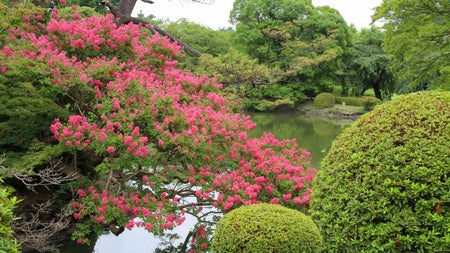
Images Depict Mature Plants
Plum Magic Crape Myrtle – Compact Red-Pink Flowering Shrub with Colorful Foliage
Vibrant color and compact charm.
The Plum Magic Crape Myrtle brings unmatched color and texture to smaller gardens and landscapes. This compact, disease-resistant variety dazzles with bright fuchsia-pink blooms that appear in early summer and last until fall. Its unique plum-purple new foliage matures into deep green, creating a bold contrast against the vivid flowers. Perfect for smaller spaces, Plum Magic delivers a big visual impact in a manageable size.
A dwarf Crape Myrtle with serious landscape potential.
Reaching 6 to 10 feet tall and 6 to 8 feet wide, Plum Magic fits beautifully in foundation plantings, mixed borders, or patio containers. Its rounded, dense form makes it easy to shape, while the continuous bloom cycle keeps color in your garden long after other shrubs fade. Whether used as a standalone specimen or grouped for a flowering hedge, this compact Crape Myrtle is a reliable, long-lasting performer.
Easy care and built-in resilience.
As part of the Southern Living® Magic Series, Plum Magic was bred for exceptional powdery mildew and leaf spot resistance. It thrives in full sun and well-drained soil, tolerating both heat and drought once established. In Zones 6–9, it’s a hardy choice for homeowners who want vivid, consistent color without high maintenance. Simply prune in late winter or early spring, and enjoy season after season of spectacular blooms.
Small size, huge versatility.
With its multi-season appeal, Plum Magic brings rich color from spring to frost and adds texture even in winter through its smooth, cinnamon-toned bark. It’s ideal for urban gardens, cottage landscapes, or container accents, offering a reliable burst of red-pink color in a space-saving size. If you’re looking for a low-maintenance flowering tree that’s equally tough and beautiful, Plum Magic is a perfect pick.

| Hardiness Zone: | 6-9 |
|---|---|
| Mature Height: | 6 to 10 feet |
| Mature Width: | 6 to 10 feet |
| Classification: | Semi-dwarf shrub form |
| Sunlight: | Full Sun |
| Habit: | Deciduous, densely branched, multi-stemmed summer through the first frost. |
| Flower Color: | Fuchsia-pink flowers in mid to late summer through the first frost. |
| Foliage: | New growth emerges a rich dark plum purple, changing to an equally vibrant orange-red in the fall. |
| Soil Condition: | Any well drained soil |
| Water Requirements: | Water well until established. |
| Uses: | Extremely attractive when used as a focal point in the mixed border, mass planting, or a specimen planting . Small enough for a large containers on the patio. |
How to Care for Plum Magic Crape Myrtle
Be sure to read our planting instructions to ensure a healthy and happy Plum Magic Crape Myrtle plant for years to come!
How do I plant a Plum Magic Crape Myrtle?
Choose a sunny location with at least 6 hours of direct sunlight per day. Dig a hole twice as wide as the root ball and only as deep. Place the plant so the top of the root ball sits level with the soil surface, then backfill with native soil and water thoroughly. Apply a 2–3 inch mulch layer to retain moisture and protect the roots. Avoid overly wet areas or poorly draining soil. Crape Myrtles thrive in well-drained, slightly acidic soil. For the best performance, amend heavy soil with compost or pine bark fines at planting time.
How often should I water my Plum Magic Crape Myrtle?
Water deeply once or twice per week during the first growing season to establish a strong root system. After establishment, Plum Magic is moderately drought tolerant and needs watering only during prolonged dry periods. Always water at the base rather than overhead to keep foliage dry and prevent disease. Mulch around the base to conserve moisture, reduce weeds, and regulate soil temperature during summer heat.
When should I fertilize my Plum Magic Crape Myrtle?
Fertilize once in early spring with a slow-release balanced fertilizer (10-10-10) to promote new growth and blooms. Avoid over-fertilizing, as excess nitrogen may encourage foliage growth over flowers. A second light feeding in midsummer can help sustain blooming into fall. Mixing in organic compost annually improves soil health and encourages vibrant foliage and flower color.

How and when should I prune my Plum Magic Crape Myrtle?
Prune in late winter or early spring before new growth begins. Remove dead or crossing branches and lightly shape for symmetry — never “top” or over-cut your Crape Myrtle, as it can harm future blooms. Since Plum Magic blooms on new wood, pruning encourages more flower production. This keeps the plant full, compact, and bursting with color every season.


















